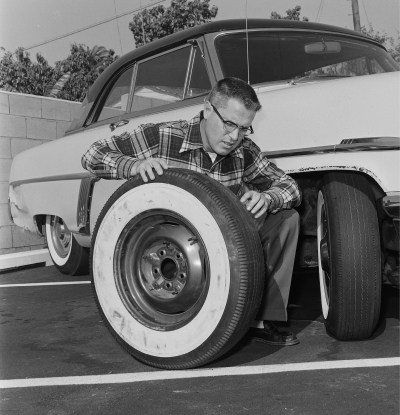By Drew Hardin
Photography Courtesy Pat Brollier, Petersen Publishing Company Archive
 “The study of tread wear is as important to a mechanic as the study of fingerprints to a detective.” So wrote SAE engineer Ed Packer to open a February 1959 Hot Rod technical article about interpreting tire tread wear. By “watching your treads,” Packer stated, “you can keep your roadster or family sedan safer and more comfortable. As a bonus, you will cut operating costs.”
“The study of tread wear is as important to a mechanic as the study of fingerprints to a detective.” So wrote SAE engineer Ed Packer to open a February 1959 Hot Rod technical article about interpreting tire tread wear. By “watching your treads,” Packer stated, “you can keep your roadster or family sedan safer and more comfortable. As a bonus, you will cut operating costs.”
On six pages, Packer took a deep dive into the conditions that could be recognized with a close examination of the tire’s treads, from simple things like over- and under-inflation to the effects of improper alignment, worn ball joints, and wheels that are not true. “Many cars are delivered with wheels that are not round!” he exclaimed. “The situation seems unbelievable.”
Packer even touched on the detrimental effects of a rowdy hot rodder: “A very conservative old gentleman with a fine big car was complaining bitterly to a factory representative of one of the tire manufacturers. His tires were wearing…and he had his entire running gear checked for alignment. It was reported perfect. Inflation was correct. But the wear persisted. Finally the truth came out. The old man’s son used the car regularly, and he apparently enjoyed its high performance.
“So if that’s the way you want to enjoy your car, cornering wear is the bill you’ll pay.”
The photo the editors chose as the opening image for this story showed Packer examining a tire from what looks like a ’52 Mercury two-door and comparing its tread to the front tire still mounted on the car. The tire on the car had even wear; the tire in his hands showed obvious wear on the inner tread. We chose an outtake from that photo shoot that showed less of the worn tire’s tread but more of the Mercury. It was fairly dinged up for what would have been a relatively new car—and one photographed for the magazine. Note the paint rubbed off the front fender lip, and the dents at the rear of the quarter-panel. Apparently, tires weren’t the only things that could tell tales to an observant mechanic.





